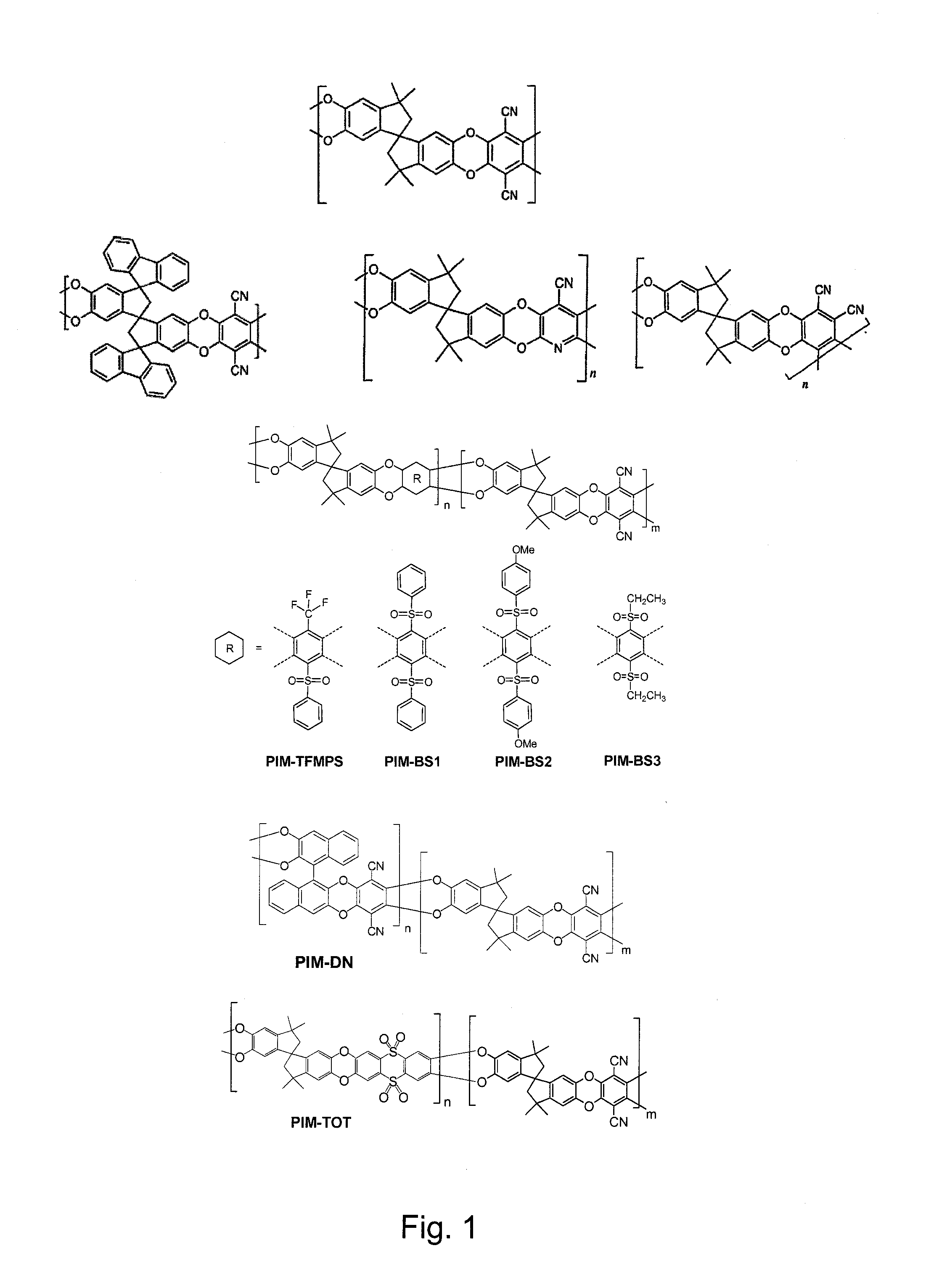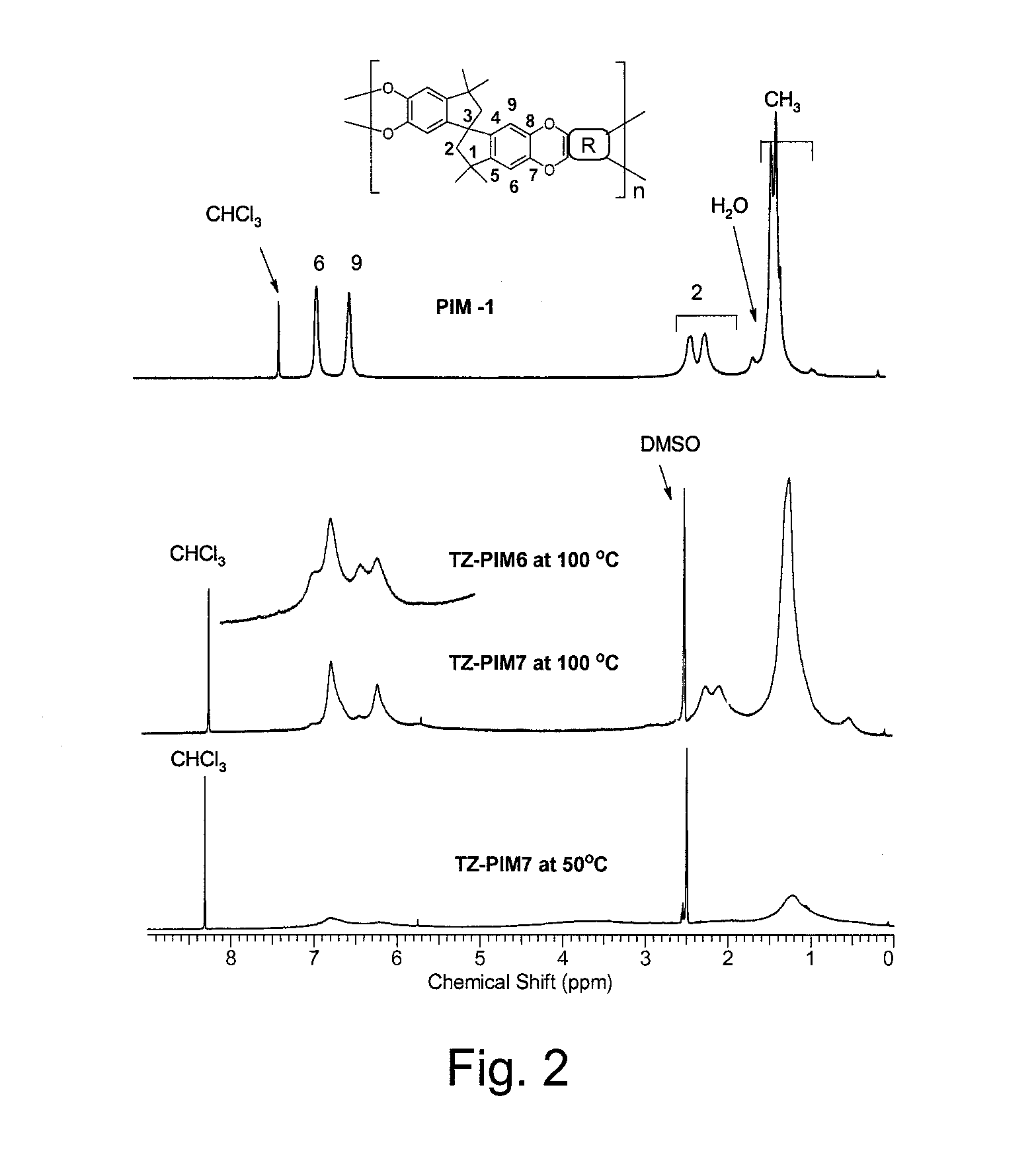Polymers of intrinsic microporosity containing tetrazole groups
a technology of intrinsic microporosity and tetrazolium tetrazolium, which is applied in the direction of metal/metal-oxide/metal-hydroxide catalysts, chemical/physical processes, inorganic chemistry, etc. it can solve the problems of large accessible surface area, high gas permeability, and the ionic liquid is held in the pores of the support via relatively weak capillary forces, so as to increase the selectivity of gas pair, the effect of extending
- Summary
- Abstract
- Description
- Claims
- Application Information
AI Technical Summary
Benefits of technology
Problems solved by technology
Method used
Image
Examples
example 1
Preparation of Tetrazole-Containing PIMs (TZ-PIMs)
From PIM-1 Solution:
[0061]PIM-1 was dissolved in NMP (1-3 g in 20 mL of solvent). NaN3 and anhydrous ZnCl2 with different mol equiv versus the nitrile groups were added, and the reaction mixture was stirred at 120° C. for different times according to the conversion required (see Table 1, TZ-PIMs4-7). After cooling to 60° C., 15 mL of diluted HCl (1:10 by volume in water) was added, and the reaction mixture was kept at this temperature for 3-5 h. The PIMs thus obtained were then precipitated into excess aqueous HCl, filtered, washed on the filter with the same HCl solution and water, and dried in vacuum at 120° C.
From PIM-1 Films:
[0062]PIM-1 films were immersed in mixed solvent of NMP / H2O (v:v=1:2). NaN3 (20 mol equiv versus the nitrile groups) and anhydrous ZnCl2 (10 mol equiv versus the nitrile groups) were added. The reactions were run under different conditions as follows and as illustrated in Table 1. The conditions were: (1) 60°...
example 2
NMR Characterization of TZ-PIMs
[0068]TZ-PM6 and TZ-PIM7 were characterized by 1H and 19F NMR spectroscopy. Comparative 1H NMR spectra of PIM-1 in CDCl3 and TZ-PIMs (TZ-PIM6 and TZ-PIM7) in DMSO-d6 are displayed in FIG. 2 along with signal assignments derived from 2D-NMR.
[0069]The intensities and the shapes of the TZ-PIM polymer 1H NMR signals were monitored at different NMR probe temperatures: 23° C., 50° C., 80° C. and 100° C. The observed signal (at 100° C.) intensity ratio for the TZ-PIM7 aromatic (6.73, 6.19 ppm, H-6, 9) and aliphatic (0.25-2.4 ppm, H-2 and CH3) regions was exactly 4H : 16H as expected from the molecular structure. Furthermore, at low temperature the intensity of all the signals in the 0.5-7.0 ppm area increased with increasing temperature. It is well known in NMR spectroscopy that changes in the sample temperature affect the mobility of the molecules, and hence, the intensity and shape of the signals. This is particularly noticeable with protons involved in hyd...
example 3
FTIR Characterization of TZ-PIMs
[0070]The FTIR spectra of the progress of reactions at 120° C. at different reaction times to produce TZ-PIM (4-7) are shown in FIG. 3. PIM-1 shows the characteristic nitrile absorption band at 2238 cm−1, while the absence of absorption bands in the range of 3000 to 3600 cm−1 indicates that no N—H groups are present. After a two day [2+4] cycloaddition Click reaction at 120° C., the relative intensity of the nitrile absorption band decreased compared with other bands (TZ-PIM4 and 5). Broad absorption bands are observed in samples TZ-PIM 6 and 7 in the range of 3000 cm−1 to 3600 cm−1, corresponding to N—H stretching vibrations with N—H•••N bond, and in the range of 2300 cm−1 to 2800 cm−1, attributed to vibrations of quaternary nitrogen atom (Vygodskii 2008). A narrow intense absorption near 1580 cm−1 arises due to the stretching vibration of the N═N and N—H groups which implies that some of the nitrile groups were converted into tetrazole groups (Disli...
PUM
| Property | Measurement | Unit |
|---|---|---|
| melting point | aaaaa | aaaaa |
| pressures | aaaaa | aaaaa |
| pressures | aaaaa | aaaaa |
Abstract
Description
Claims
Application Information
 Login to View More
Login to View More - R&D
- Intellectual Property
- Life Sciences
- Materials
- Tech Scout
- Unparalleled Data Quality
- Higher Quality Content
- 60% Fewer Hallucinations
Browse by: Latest US Patents, China's latest patents, Technical Efficacy Thesaurus, Application Domain, Technology Topic, Popular Technical Reports.
© 2025 PatSnap. All rights reserved.Legal|Privacy policy|Modern Slavery Act Transparency Statement|Sitemap|About US| Contact US: help@patsnap.com



